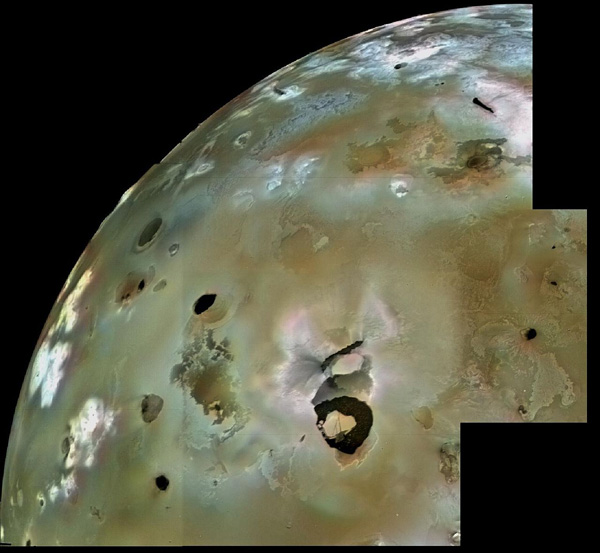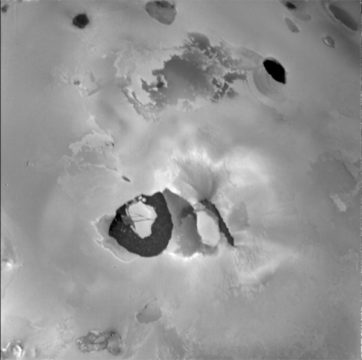When Will This Trickster Volcano Erupt? – Sky & Telescope
Loki, a faraway volcanic feature on Jupiter’s moon Io, is acting up and planetary scientists want to know why.
Loki has always been a troublemaker.
This particular Loki is a bowl of magma on Jupiter’s moon Io. For a while, Loki brightened and faded with surprising regularity, but then it started misbehaving — Loki completely stopped its regular behavior for a decade, then seems to have restarted on a different timescale. Now, planetary scientists are trying to make sense of what’s happening on this faraway volcanic world.

Loki Patera is the dark, U-shaped feature near the center of this image from Voyager 1.
NASA / JPL / USGS
The Changing Loki
Io orbits Jupiter so closely, the giant planet’s gravitational tidal forces tear at the moon’s insides, heating up the interior and bringing magma to the surface.
In the case of Loki, that magma appears to be surfacing in an overturning lava lake. You can see images of an overturning lava lake in Hawai‘i here. Needless to say, images of Io leave a lot more to the imagination. After all, the moon is currently more than 600 million kilometers (370 million miles) from Earth. Nevertheless, ground-based telescopes such as Gemini North and Keck II on Maunakea, Hawai‘i, can make out the volcanic features on this moon with the help of adaptive optics. This technique removes some of the blurriness of our atmosphere, giving astronomers images that rival those taken from space.
From 1988 to 2000, Loki brightened and faded roughly every 540 days. This long-term cycle is typical of a lava lake: Magma surfaces bright and hot, then gradually cools, hardens, and sinks to bottom of the lake. Then the process starts over.
But, as Julie Rathbun (Planetary Science Institute) puts it, ““Loki has already mis-behaved once.”
“I first found Loki’s periodicity in the early 2000s and published a paper in 2002,” Rathbun explains. “Immediately after, the periodicity stopped.”
Loki’s behavior appeared to be more random over the following decade, though it’s difficult to tell as observations were also taken less frequently. But when observing campaigns started in 2013, they found evidence that the lava lake had found a new rhythm, with a period around 475 days long.
Rathbun presented a model explaining these observations at this week’s joint meeting of the European Planetary Science Congress and the American Astronomical Society’s Division of Planetary Sciences in Geneva, Switzerland.
The new periodic behavior is still consistent with a lava lake, she explained. Before, Loki had a longer cycle and didn’t get as bright. Now, Loki gets brighter but for shorter lengths of time. These observations make sense if a larger area of the lake is being revealed, making for a brighter spot in images, but then resurfaces more quickly, leading to a shorter timescale. Fresh, more porous lava could explain the change.
“If there are more bubbles in the lava, it may make the crust overturn sooner, sort of like carbonation in soda affects how ice floats in a drink,” Rathbun explains.
A Trickster Tricks
Katherine de Kleer (Caltech), who was not involved in this study, agrees that this change in timescale, if real, would mean a change of conditions at the volcano.
But she offers an alternative: The period might never have changed. “Much of the data are sparse,” de Kleer explains. So sparse, in fact, that the data collected so far could match both a model where the brightening timescale changes and a model where the timescale stays the same.
Time — and lots of observations — will tell whether Loki has played a trick on us.
“I currently have observing time scheduled on the telescope this Friday, next Friday, and then every 1-2 weeks through the end of the calendar year,” Rathbun says. Check back with her on Twitter (@LokiVolcano) to see what happens!







